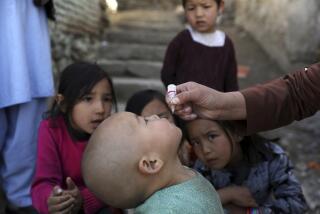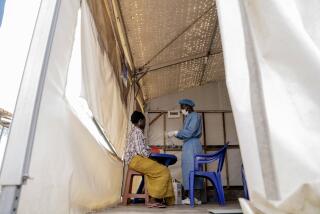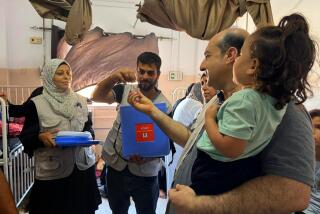Victory Over Polio Declared in Americas
WASHINGTON — Polio--the dreaded scourge that killed or paralyzed millions of children in the world and caused near-hysteria among U.S. parents earlier in the century--has been eradicated from the Western Hemisphere, the World Health Organization declared Thursday.
This achievement “should be a source of pride to all of us and it shows what can be done when everybody works together for a common cause for the benefit of mankind,” said Dr. Carlyle Guerra de Macedo, director of the Pan American Health Organization, which is the Western Hemisphere office of WHO.
“Let us now hope that the example set in the Americas is followed by the rest of the world, so that after the year 2000 no child will ever again fall victim to this dreadful disease,” he added, speaking at a press conference.
Pan American Health officials attributed the success to an aggressive and widespread $540-million immunization campaign launched in the region in 1985.
The last documented case of polio in the Americas was recorded in 1991 in Pichanaki, a village in Peru. A 3-year-old boy was afflicted. The last case in the United States occurred in 1979, according to Pan American Health.
But 120,000 cases still occur annually in other parts of the world, most of them “in the poorest and most politically unstable areas,” officials of the organization said in a statement.
The disease largely has declined worldwide, with the Eastern Mediterranean region the sole exception, where a 24% increase was reported in 1993, particularly in Pakistan and the Sudan, Pan American Health said. China, which reported epidemics of more than 5,000 in 1989 and 1990, has mounted a major immunization program. In 1993, Europe recorded 187 cases, of which 161 occurred in nine of the newly independent states of the former Soviet Union.
Poliomyelitis, or infantile paralysis, is an infectious disease caused by a virus that attacks the central nervous system and can produce paralysis and death by asphyxiation. There are no effective drugs to treat it.
Patients whose respiratory cells have been destroyed usually require a respirator to control breathing and keep them alive. The image of a child in a so-called “iron lung” became a terrifying specter in this country during the height of the epidemic in the early 1950s--particularly 1952, when the United States experienced an explosion of thousands of cases.
Fear of infection led parents to take extreme measures. Because outbreaks mostly occurred during summer, parents frequently would shelter their children at home when warm weather arrived. Children were often forbidden to play in parks or use public swimming pools. Households with an infected family member were placed under quarantine and isolated from the community.
The first effective vaccine against polio was developed by Dr. Jonas Salk in 1954. Salk’s vaccine, which was put into widespread use in 1955, was injectable and used killed polio virus to provoke immunity.
Between 1957 and 1959, Dr. Albert Sabin developed an oral vaccine that used a live but weakened virus. The Sabin vaccine was licensed in 1961, and continues to be the vaccine most widely used in the world today.
The disease mostly afflicts young children, although adults also are susceptible. In fact, the most famous American stricken was President Franklin D. Roosevelt, who fell ill at the age of 35.
Pan American Health officials said that the battle plan to immunize the region’s children involved several strategies. These include national vaccination days, when most of the infant population is vaccinated; “sweep operations,” when health care workers immunize children, house to house, after a suspected case is identified, and intensive surveillance efforts to detect new cases.
By 1985, 11 countries classified as “endemic”--that is, having had at least one confirmed case during the previous three years--began to sponsor national vaccination days on a semiannual basis. Officials of the Western Hemisphere organization said that this often involved massive education campaigns in advance.
Before the civil war in El Salvador ended, for example, Pan American Health negotiated with guerrilla fighters and the military, asking them to declare a temporary truce and respect a cease-fire during the vaccination day, the organization said. In Peru, Pan American Health sponsored a press conference to inform the nation--and Shining Path guerrillas--of the coming vaccination effort.
The most difficult problem was finding ways to keep the vaccine cold, organization officials said. The medication requires constant temperatures below 10 degrees Centigrade (50 degrees Fahrenheit).
In Peru, for example, many of the cold packs were kept frozen every night in refrigerators loaned by villagers. In Lima, during an especially hot summer, more than 10 tons of ice were needed to preserve the vaccine.
The campaign was funded by the collaborative effort among countries and agencies, including $430 million provided by the countries themselves, and the remainder from collaborating agencies.
These included the U.S. Agency for International Development, Rotary International, United Nations Children’s Fund, the Inter-American Development Bank and the Canadian Public Health Assn. AID officials said that the agency contributed $79 million between 1986 and 1994.
WHO said it would concentrate its efforts next on the complete eradication of polio in the rest of the world, as was achieved with smallpox in 1977.
Also, it will turn its attention to launching a similar effort against measles, another vaccine-preventable illness that kills 1 million people annually, most of them children. Polio-eradication programs have left a health infrastructure within the Americas “that will facilitate the struggle against measles,” Pan American Health said.
The organization said that it hopes polio can be wiped out by the year 2000. Today, 81% of the world’s children have received the vaccine, it said.
“The challenge . . . will be to reach the remaining 20% of children who live in the most isolated and impenetrable areas of the world,” the organization said.
More to Read
Sign up for Essential California
The most important California stories and recommendations in your inbox every morning.
You may occasionally receive promotional content from the Los Angeles Times.










